Sandwich: A delicious slice of old, medieval England

SANDWICH, England — I once had a chateaubriand in Chateaubriant. Yes, it was better than the chateaubriand I had in San Francisco and Chicago. I sat outside a small family run restaurant in that isolated, riverside town in northwest France and watched the Tour de France race by. Even the bread tasted better.
Speaking of bread, I recently had a sandwich in Sandwich. Even a simple sandwich tastes better here. So did everything else while gazing out of rain-splashed windows at one of the most authentic medieval villages in England. Sandwich is as well-preserved as the Crown Jewels.
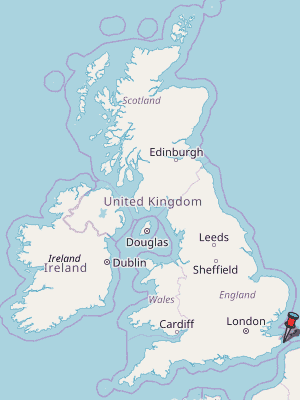
I had some time between assignments in England last month and wanted a couple days in an authentic English village. I wanted to escape mass transit, crowded pubs and chain restaurants that have Americanized much of the United Kingdom. I first chose Rye, a town of 9,000 on the southeast coast that lays claim to being “The Prettiest Town in England.” The prices of the hotels I saw available made it also look like “The Most Expensive Town in England.”
A little more research led me to Sandwich, about half the size of Rye, 40 miles to the northeast and slightly inland. I read it’s like “a living museum” and was once the most important port in England with narrow, crooked streets, a charming old town and a sleepy river where you can drink a pint on the banks.
Sandwich has also been one of the iconic settings for the British Open over the years. My old sportswriter’s curiosity drew me here more than my iron game which I long ago shucked into a Colorado pond after losing all my golf balls.
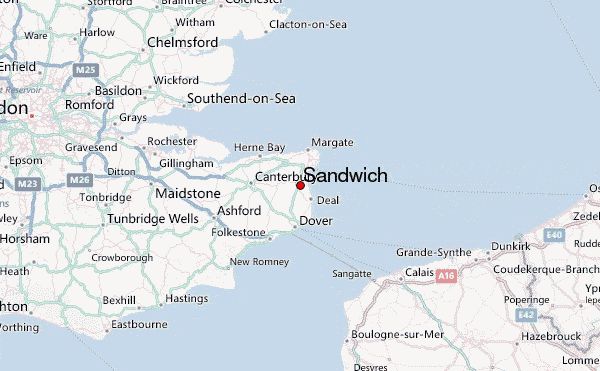
Sandwich is a true riches to rags to riches story, a civic comeback worthy of more notoriety than the Western world’s favorite lunch food.
The journey
This was an easy choice. On a crisp, gray October morning, I took a train from London’s St. Pancras Station south about 1 hour and 45 minutes. Southern England is to Northern England what California is to the Rust Belt. Tall, rocky cliffs. Long, unspoiled shorelines along a blue-green sea. Bright green meadows that look like fairways at Pebble Beach.
Pulling into Sandwich I asked the station clerk about the train back to London the next night and directions to the Quay, Sandwich’s quaint waterfront.
“You going to the Bell Hotel?” she asked.
“Yes. How did you know?”
“It’s the only hotel in Sandwich.”
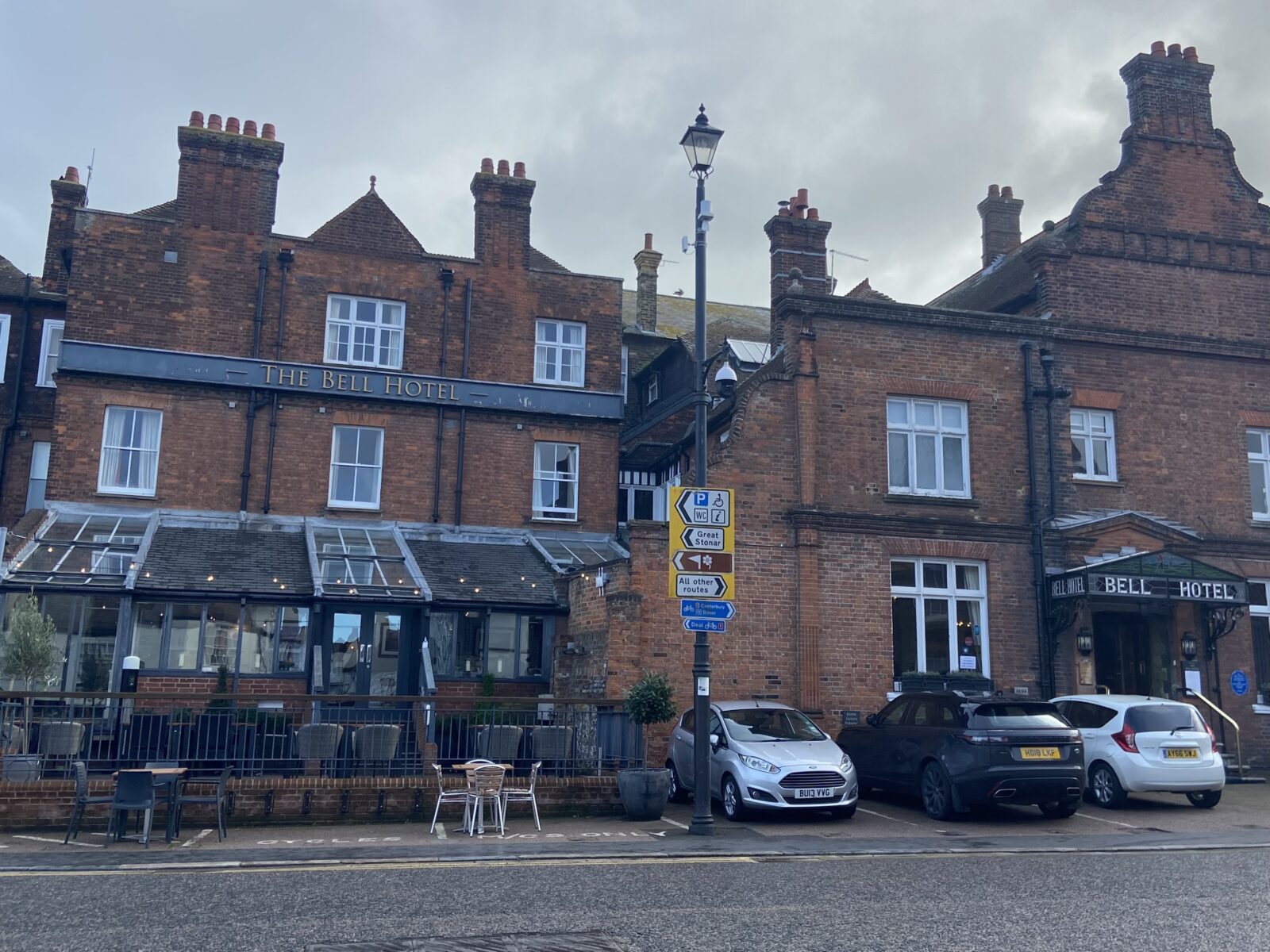
As I started dragging my roller bag the 15 minutes to the hotel, a total stranger, a middle-aged, fit man with a kind face, overheard us and said, “I’ll give you a lift.”
He and his wife moved just outside Sandwich decades ago and would never go back to the city. I’d read that people here are among the friendliest in England. Italians are the friendliest people I’ve ever met. Yet I’ve never had an Italian at a train station offer to drive me to my hotel.
I asked his wife in the car what she likes about Sandwich.
“It still has independent shops,” she said.

That sounds pretty benign — unless you’d just come from London where all the pubs on my street in the Hammersmith neighborhood were chains resembling so many TGIFs. Parts of England seem as homogenized as the milk they put in my cafe latte every morning.
The Bell Hotel, however, looks as English as a cup of tea on the bank of the River Thames. Parts of it date back to the 1200s and restored in the 19th century, it’s a three-story brick hotel with little smoke stacks sticking up from various chimneys. Inside the revolving oak door is the lobby with period furniture and an elegant restaurant and bar that puts out some of the best local dishes in the South of England. Brasswork is everywhere. The Bell just drips in medieval romance.
I felt like a visiting knight in a royal court.
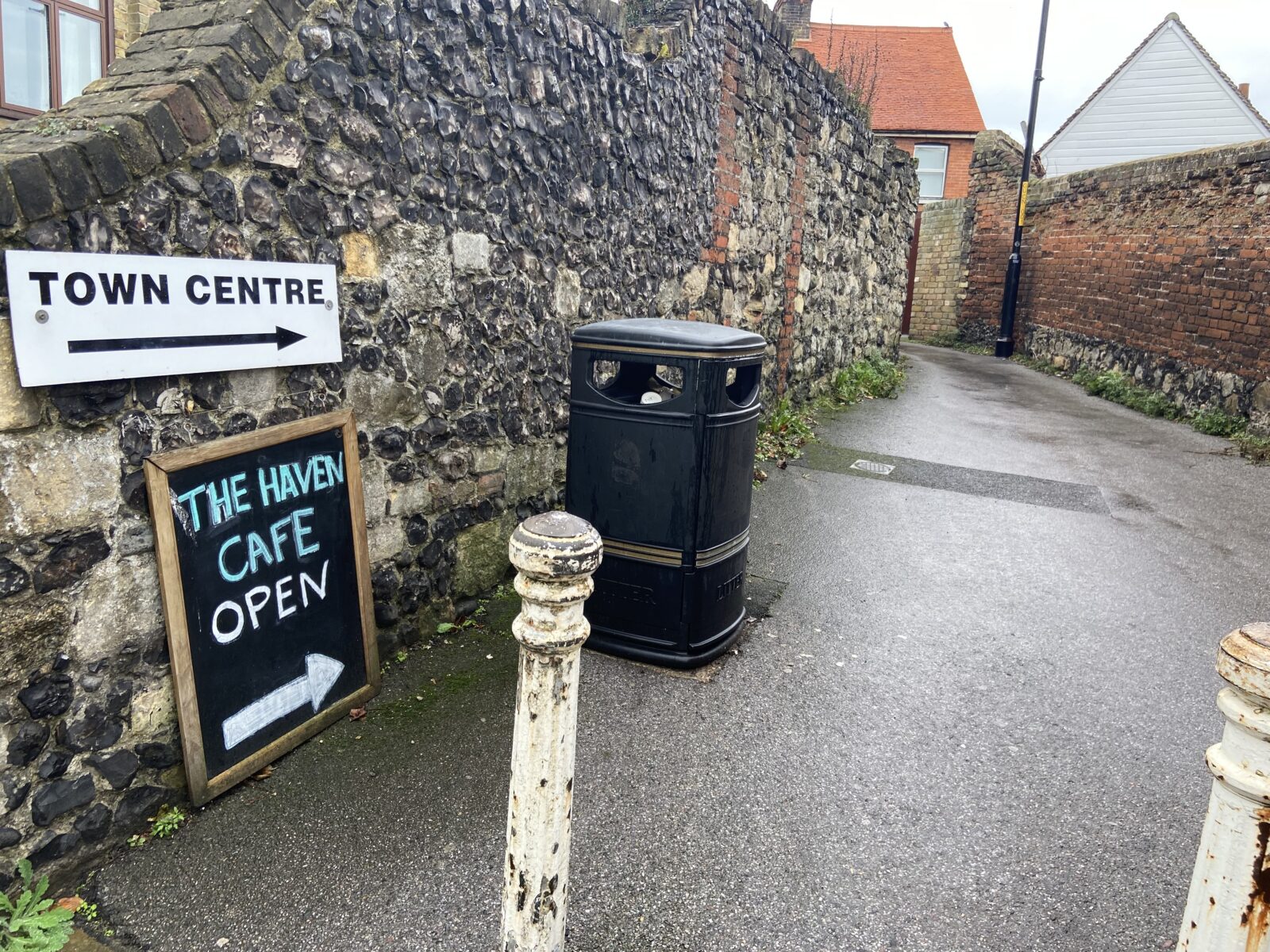
The town
When I visit a new place, I always start with a walking tour. Many capitals do organized tours, but Sandwich can be covered in a morning stroll. Across the street from the hotel is a passageway between a brick wall and what must be a 1,000-year-old stone wall. A sign reading “TOWN CENTRE” points ahead.
In about one minute, I came across St. Peter’s Church. Built in 1301, destroyed twice by the French and almost by an earthquake, the stone church has a World War I brick memorial to all “those men of this town who went forth to fight for God, king and country and came not back again.” It hasn’t functioned as a church since 1948 when the parish merged with two other churches. Today it serves as a historical building and reminds townsfolk of its conservative past as it still rings a “curfew bell” every evening at 8.
It also serves as a daily indoor market selling vintage clothes, hand-made jewelry, glassware and kitschy signs with messages such as “A true friend is one who makes you laugh so hard you pee a little.”
The church marks the beginning of old town, a series of small streets all meeting at odd angles with stores like No Name Shop French Deli & Bistro and the Sandwich Sausage Company. (“No Artificial Ingredients.”)

Also here in the quaint brick town square encompassing the town council and town museum is the aptly named The Sandwich Shop. Yes, they serve sandwiches in Sandwich. Here’s the story behind your favorite lunch food:
In 1762, John Montagu, the 4th Earl of Sandwich, was an English aristocrat with a fondness for gambling at cards. During a particularly long session, he ordered his valet to bring him a slab of meat slipped inside two slices of toast. It allowed him to eat without a fork, keeping his hands free for holding cards, and the bread kept him from making the cards greasy. So no, as one inane friend asked me, the town was not named after a sandwich. It was the other way around.
Sandwich’s Sandwich Shop (I love writing that) is a tiny spot with homemade goods and fresh sandwich ingredients. My roast beef on homemade whole-grain bread and an Oasis health drink were all of 6.50 pounds (about $8.70) and the best bargain I’d found in more than a week in England.

Architecture aficionados would love Sandwich. It’s known for having the largest collection of half-timbered buildings in England. As I wandered aimlessly among the narrow residential streets, I passed numerous snow-white buildings with brown wood frames, making them all look like giant chocolate-striped cupcakes.
But beyond the beautiful buildings are signs of an ugly past. I came across a barren field, long left to overgrown weeds locked behind an iron gate. The abandoned feel belies its historical significance. This is Gallows Field. This is where they hanged and buried alive felons. The last execution was in the 1790s of two deserting soldiers. The original key remains in the gate.


I asked a local how long can one stay alive underground.
“How long can you hold your breath?” he said flippantly.
Running along the field is a creek covered in green silt and fallen leaves. This is where they tied up witches and threw in to drown.

The Town Path
Sandwich has some of the best weather in the UK. Then again, that’s like saying Jeddah has some of the best bars in Saudi Arabia. Sandwich only has about eight days of rain per month as opposed to 12 in Manchester and Cardiff. But when it rains, it does pour.
A monsoon hit me as I strolled the handy, paved Town Path that rings the town. However, England always looks better in the rain, more authentic. Sitting in a warm pub with a cold pint and a Dick Francis novel, I feel warmer than on a tropical beach.
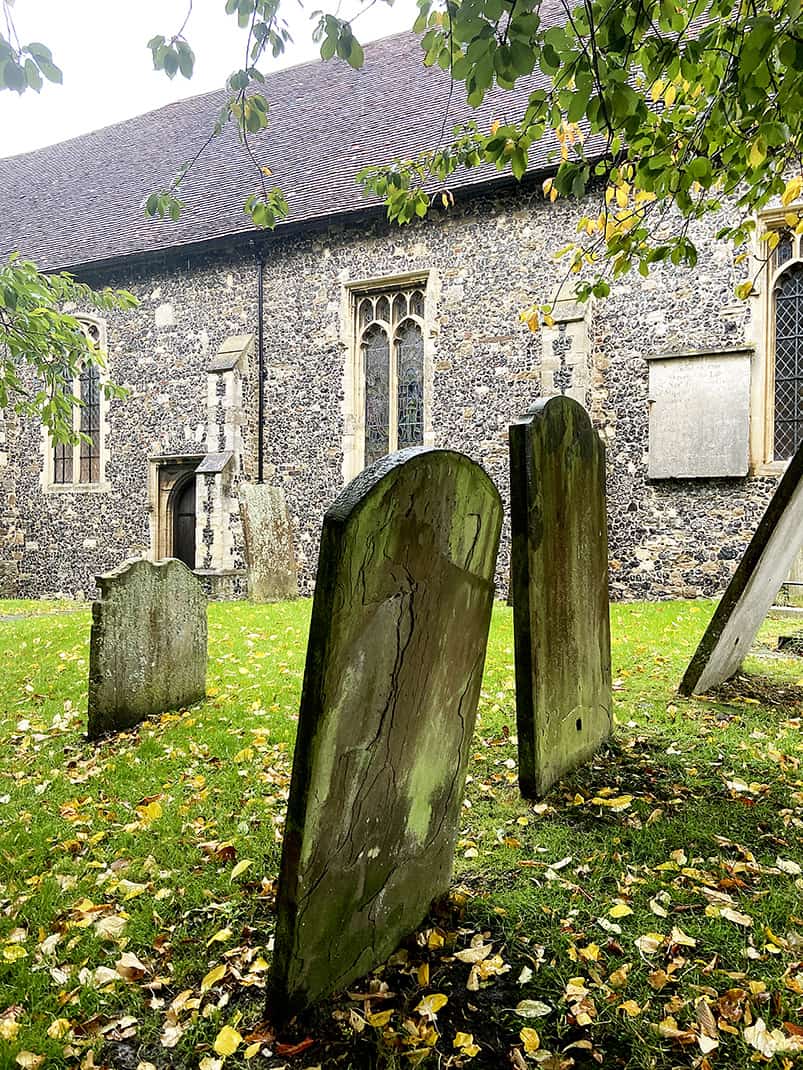
Walking in a downpour that plastered my Ben Hogan hat to my hair wasn’t even that bad. It didn’t obscure the trees lining Delf Stream, which supplied the town’s water until the late 19th century, or the neat lawn bowling field, looking like a putting green from nearby Royal St. George’s Golf Club. A hatless woman walked her dog. A man jogged by. Bells pealed from St. Clément’s, the stone church next to a graveyard as per English tradition.
The path led to The Butts, an enormous grass field built in 1384 where King Henry V had his archers train. Because medieval England was a favorite target of foreign raids, every boy over the age of 12 was expected to practice archery after church.
Today it’s a cricket field.

The pubs
I’ve always said that the easiest country to get inside its culture is England. Just go to the local pub. Each pub represents the neighborhood pulse, flocked by locals to give you the latest buzz. The English craft beer scene is also expanding and today you get lovely local pints fresh from an array of multi-colored spigots behind the bar.
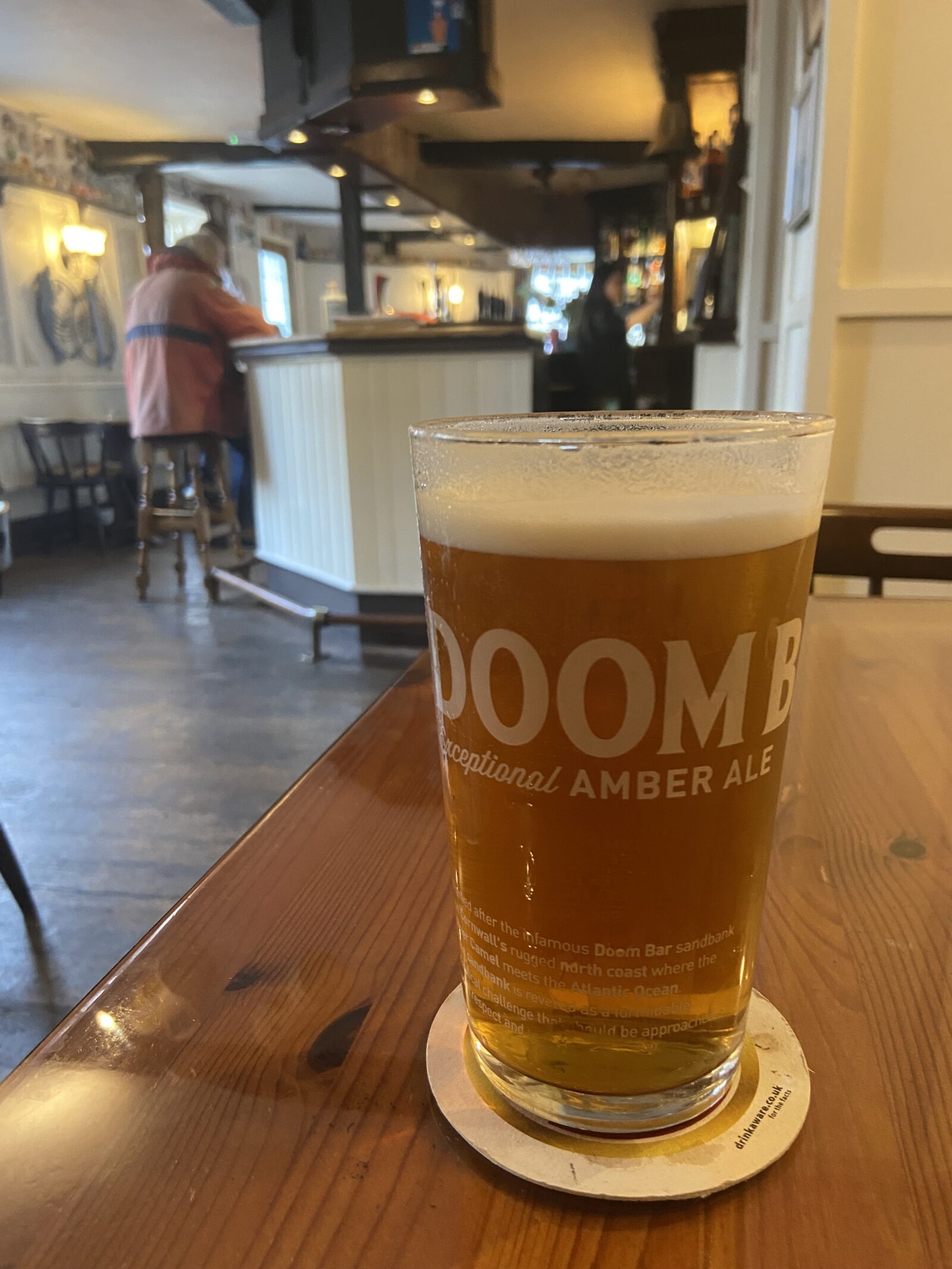
Across the street from The Bell is The Crispin Inn. Built, ironically from an America’s point of view, in 1492, its back room is the original. The bar is long and curved with a wooden floor with big windows, perfect for reading with a pint of Doom Bay Amber Ale from the Cornish Coast.
Even older is the George & Dragon up the road. Built in 1446, its ancient brick walls line high tables where couples canoodle and locals gather around the U-shaped bar. I met a couple who had been coming from London since 1981 and finally moved to Sandwich full time in March 2020.
Jean Richards is a staunch supporter of Brixit and Boris Johnson. I gave her a pass because she’s also a staunch critic of Donald Trump. She said Sandwich is a big supplier of hops for beer and orchards for fruit. It’s how it got the nickname “The Garden of England.”

I asked why shy loves living here
“I love my garden,” she said. “I can see the sun all around my house. We’re slightly protected. I believe if it’s rainy everywhere else, it’s sunny here.”
The history
Across the square from The Sandwich Shop is the Guildhall Museum. Meeting me at Sandwich’s most important building was Clive Hancocks, a 70-year-old veteran of 30 years in the Royal Air Force. Tall with longish, white hair framing a balding pate, he could pass as an old clerk in the House of Lords.
Clive has lived in Sandwich since 1983 when he was stationed here and is one of the town’s top historians. He guided me through the Guildhall which chronicles Sandwich’s history from its days as a Roman colony to modern times.

About 500 years ago, Sandwich was England’s most important city outside London. It sat near both the Strait of Dover and the North Sea and 400-600 ships passed through the area every year. Sandwich was one of England’s five major ports known as Cinque Ports.
Some interesting points of interest about Sandwich’s history:
- In 1457, a Frenchman named Marshall Pierre DeBreze, during England’s many battles with France, slipped into town and murdered mayor John Drury. Ever since, Sandwich’s mayors wear black.
- Thomas Payne, who helped write the Declaration of Independence, lived in Sandwich making ropes for ships. He was friends with Benjamin Franklin who invited him to America where he became a revolutionary. Because the French helped the U.S. in its revolution, he went to France to help with their war. The French arrested him as he was from England and sentenced him to death. However, when it was discovered he by then was an American citizen, they released him. “He came within two weeks of having his head chopped off,” Clive said.
- During World War II, 4,000 Jews escaped Germany and were put in a camp on the other side of the Quay.
- The museum has a Roman marble head of Emperor Commodus dating back to the 2nd century A.D. It was found in Sandwich two millennia later. A storm blew down a tree and boys aged 10 and 12 found the bowl under the roots. One of the boys, Tony Cooper, later married and his wife brought it to the museum just eight years ago. It’s believed she said, “Is this anything important?”
Sandwich’s high stature faded when its coastline silted and the sea receded. It also stopped collecting taxes for the king. Today, Sandwich sits about three miles from what is now Sandwich Bay. The town fell into ruin and neglect, filled with abandoned buildings and overgrown fields.
“We were at the time of Sandwich’s height, the most important port in the whole of the country,” Clive said. “We imported more wine in Sandwich than any other port aside from Bristol. And we lost all those traditional rites as other ports grew.”
Clive took me to a small room holding a torpedo. It was a scaled-down replica designed by Robert Fulton, one of America’s greatest engineers who introduced it to the Royal Navy. The Navy, however, declined to use it, saying it was an “unfair weapon” and the U.S. used it to defeat the British in the War of 1812.
“Napoleon called him a charlatan because he didn’t believe in Robert Fulton’s devices,” Clive said.
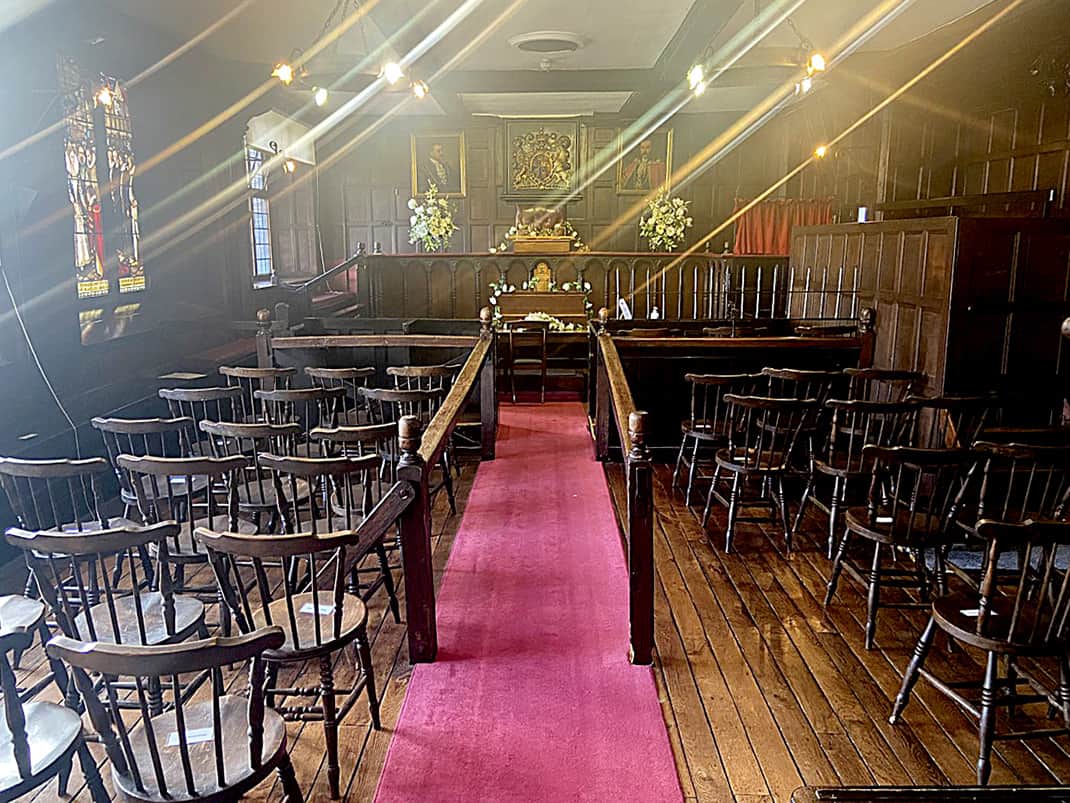
The museum’s gem is its courtroom, a near exact replica of how it looked when it opened in the 16th century. It has the same jury box and criminal’s chair where they hung sweet-smelling plants on the surrounding railings to protect the audience from the prisoner’s stench.
They also have a press box, (A sign even says “PRESS.”) On the wall is a slot where reporters would scribble “GUILTY” or “INNOCENT” on a piece of paper and slip it through the slot where a boy would race the news to the paper for publication.
“They could get the story out before the judge signed off on the court case,” Clive said.
The room hasn’t been used for trials since the 1970s, long after outsiders began buying the abandoned buildings and kept to strict codes in preserving the look. The room is now part of the city’s comeback. It’s not only a tourist attraction but is used for weddings and ship payments that the Sandwich’s mayors have received since the Dark Ages.
After 2,000 years of history, I ended my wonderful stay with another long English tradition: Sunday afternoon roast. The Bell put out a great spread of a big pile of sliced pork with gravy, stuffing and potatoes. I then hopped a bus and train for a long, dark ride back to London, leaving behind a slice of medieval England that I hope never joins the modern world.
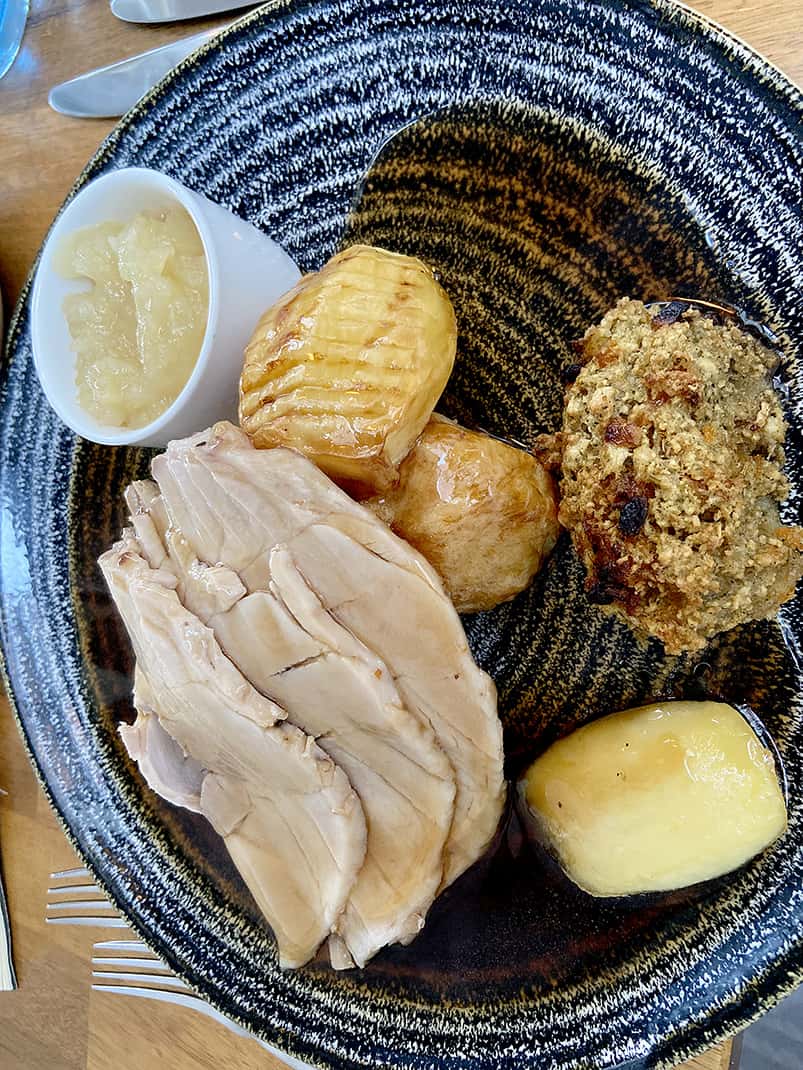
If you want to go …
How to get there: Several trains a day leave London’s St. Pancras Station for Sandwich. The 1 hour, 45-minute ride, usually through Ashford International, is listed as about 50 euros. Book ahead online as I did. I paid about 16 euros.
Where to stay: Bell Hotel, The Quay, 44-01304-613-388, www.bellhotelsandwich.co.uk. I paid 126 euros for one night but they currently have offers for about 70.
Where to eat: The Bell has the best food in town. I paid 25 euros for a big Sunday roast in an elegant setting.
When to go: July and August can get crowded but warm by England standards, up to 79. January is the worst month, the rainiest with highs of 36 degrees and lows of 22. In October it was 45-60 and dry with fall colors.
For more information: The tourist office (www.open-sandwich.co.uk) is in the Guildhall museum in the Cattle Market square, 10 a.m.-5 p.m. Wednesday-Sunday.


November 16, 2021 @ 8:40 pm
I spent a good 2 hours showing John around the Guildhall museum and telling him some of the history of the Port/Town. I love how he describes me in his blog.
There is much more to see around the Port/Town and any visitor will enjoy the history of this famous Cinque Port. You will be told about Richard the Lionheart, Thomas Becket, Henry V, Elizabeth I and the gift of an Elephant from the King of France that was landed on the Quay and then walked into the town through Fisher Gate and onwards to London where it spent the rest of it’s life in the Kings menagerie in the Tower of London
Sandwich is a historical gem in a quiet corner of Kent, just 12 miles from Canterbury.
For the golfer’s out their. We have St Georges GC where they held the 2021 Open which was won by Collin Morikawa. There are also 2 other Championship courses: Princes GC and Royal Cinque Ports, Deal.
November 16, 2021 @ 11:01 pm
I loved reading this. I’m a long lost cousin of Clive’s and I had every intention of visiting him in 2020 (from New Zealand) but the world and my health turned to custard. I don’t know if I’ll ever be able to visit now but this blog gave me a taste of what I have missed thank you John
November 20, 2021 @ 12:20 am
Hi Geni,
I do hope your health is improving enough for you to travel next year.
I was born and bred in Sandwich in 1965 and moved to NZ in 1988. This was a nice little piece on my hometown but do advise all travellers to go look for themselves as Sandwich has so much more to offer than what was mentioned.
November 17, 2021 @ 9:57 am
Interesting to see our Town from another’s perspective..and amusing if somewhat inaccurate!
November 17, 2021 @ 7:29 pm
Dianna Jones,
“Somewhat inaccurate”?
Where
November 17, 2021 @ 8:27 pm
I disagree that a stroll around Sandwich is completed in one morning. I moved to Eastry 12 years ago and everytime my son visited from France, we would go for a stroll in Sandwich before we had to say our goodbyes. He was 11 or 12 when this started – he loved it. Since then – he now lives with us – we have never tired of walking the Rope Walk, down Holy Ghost Alley, past the old Goal, the bowling green, the cricket pitch, along The Strand and stop to admire the fine arts gallery, the Quay, idle along the river, the conservation area around the primary school, Fisher’s Gate…all the time admiring the architecture, just chatting, or not even needing to say much…the peacefulness of a stroll in Sandwich is enough to satisfy the soul.
This is more than a morning’s timetable and will reward anyone who takes the trouble to plough the alleys, lanes, streets of Sandwich on more than one occasion, as you will also notice so much you missed before.
November 18, 2021 @ 7:43 pm
It is so refreshing to read such warm comments with no political diatribe, as too often encountered in other social media. Thanks for your review, John. Cyndy and I love Britain and have spent a lot of time there on business and for pleasure (including on our honeymoon, which included walking along Hadrian’s Wall in the far north), but have not made it to Sandwich. Visited nearby Canterbury once. We must include Sandwich on a future trip.
November 19, 2021 @ 10:17 pm
Delighted to read about my husband Tony Cooper’s discovery of the head of Commodus which he and a friend found as boys decades ago in amongst trees by the railway line below the escarpment of the Roman Richborough Fort. It’s interesting to read that when I took it to Sandwich Museum I said “ Is this important?” It was very precious to us! Now we are very proud it has prominence in the museum !
November 20, 2021 @ 12:13 am
Those of us lucky enough to live here count ourselves blessed. There is a strong sense of community and yes , people really are friendly and welcoming. Almost everything that one might want can be bought or found in the shops here and of course , lots of lovely , local produce .
And we are near the sea ! ( And France ) .